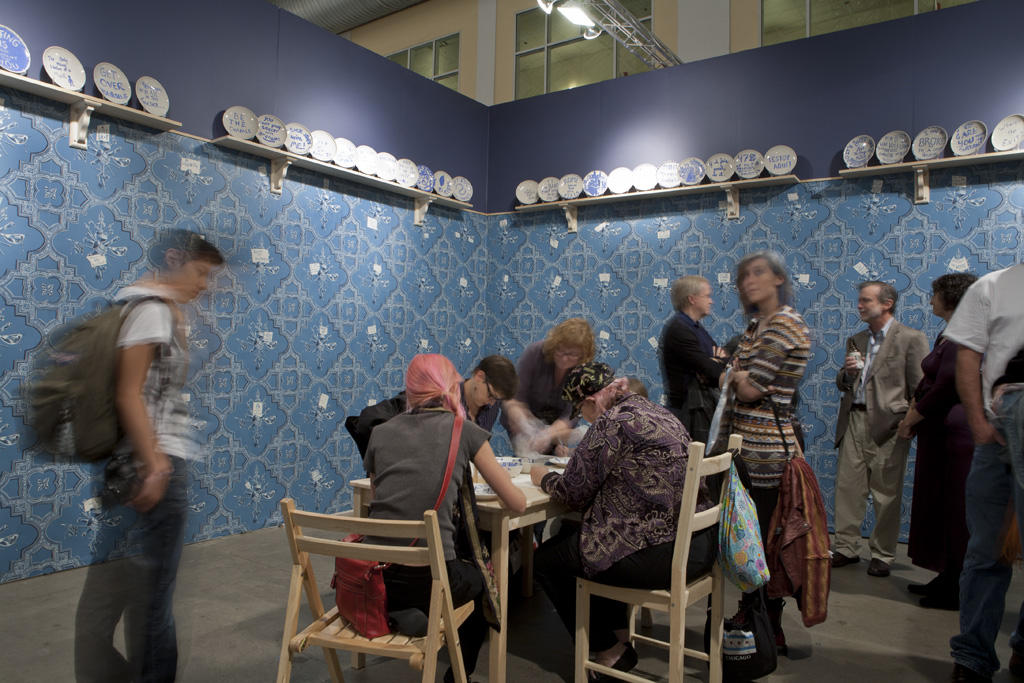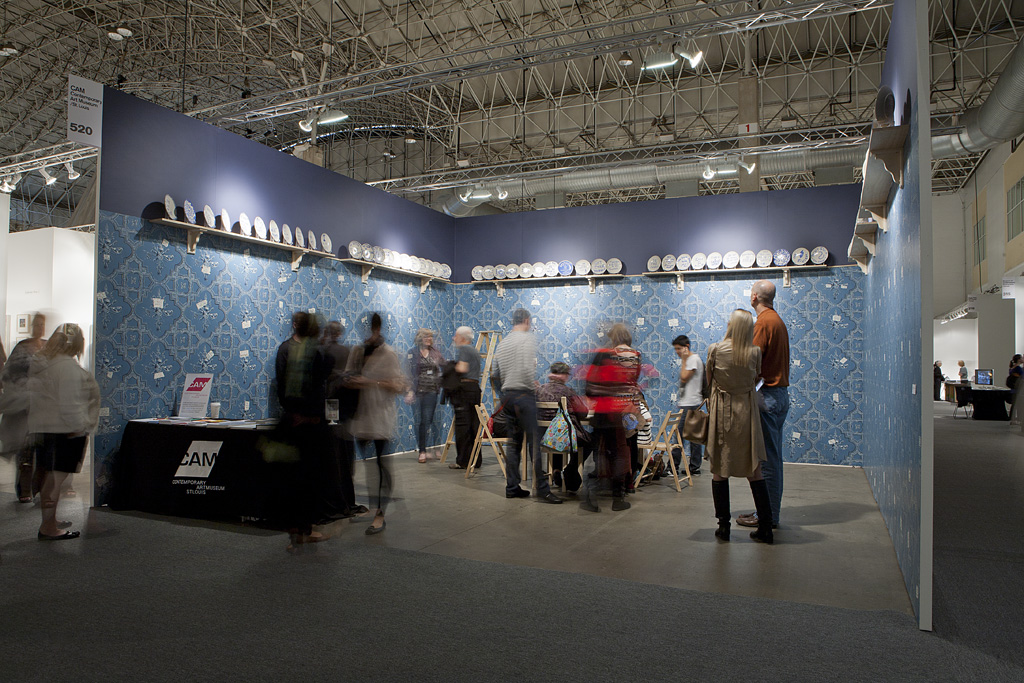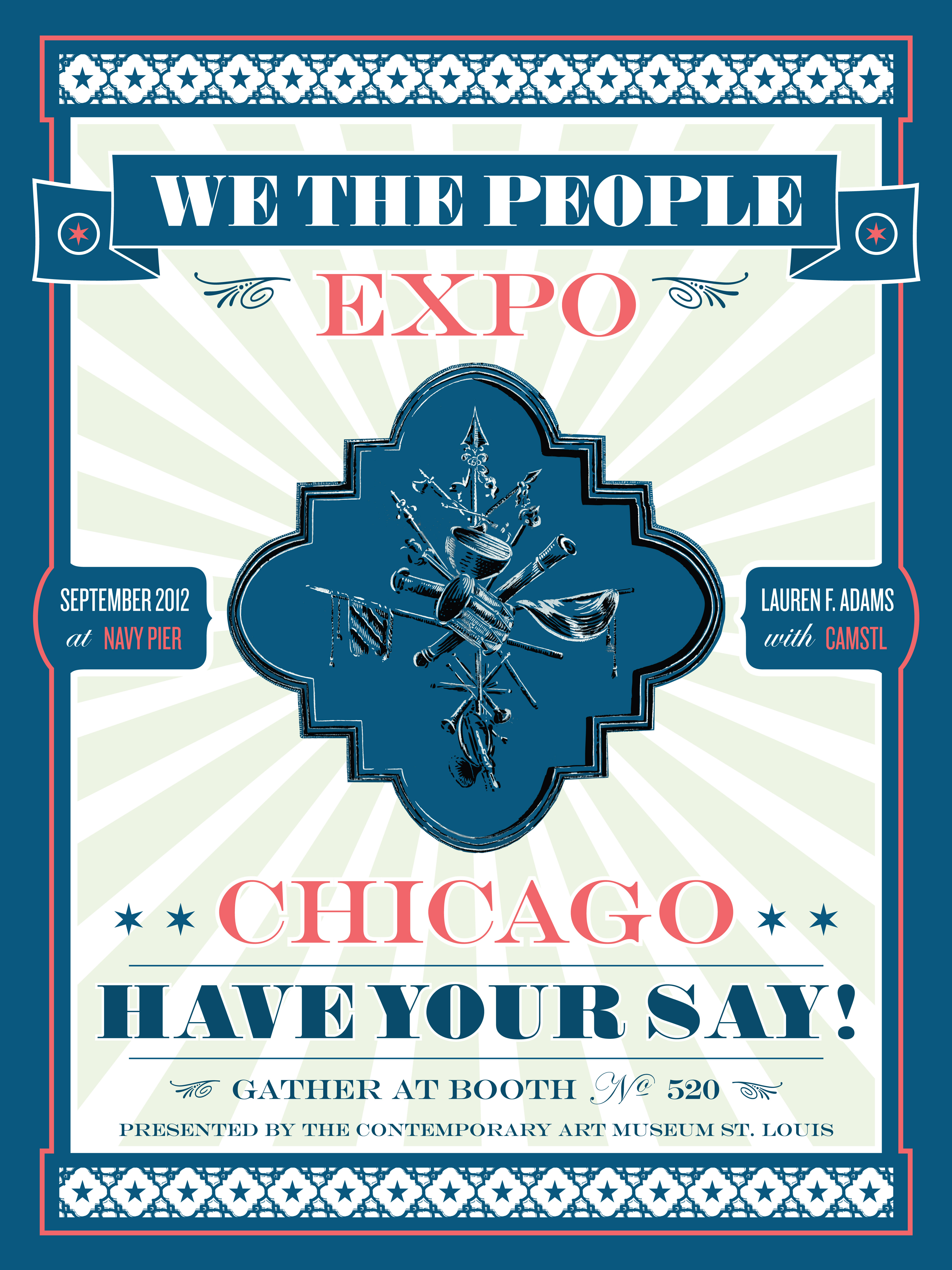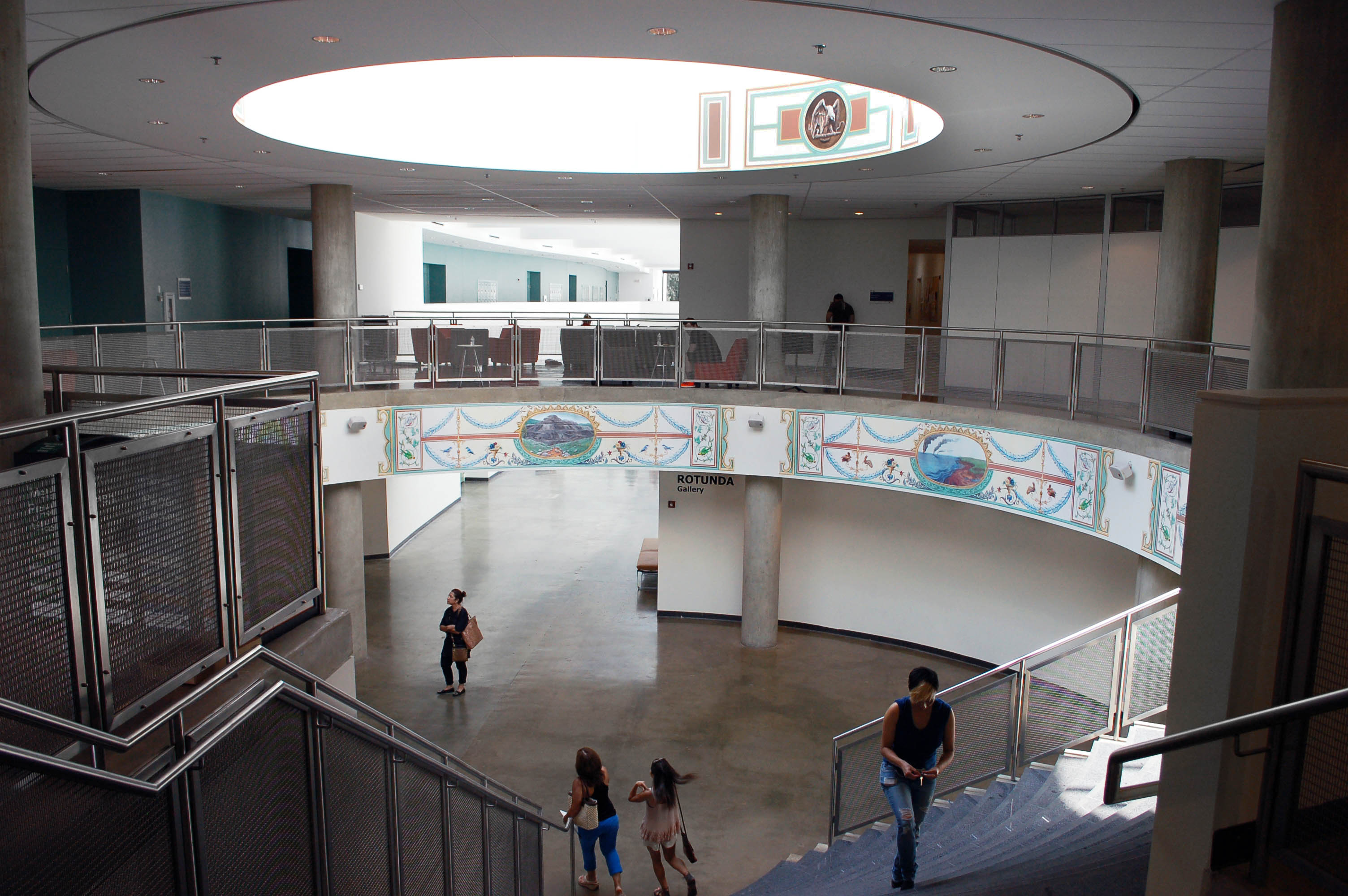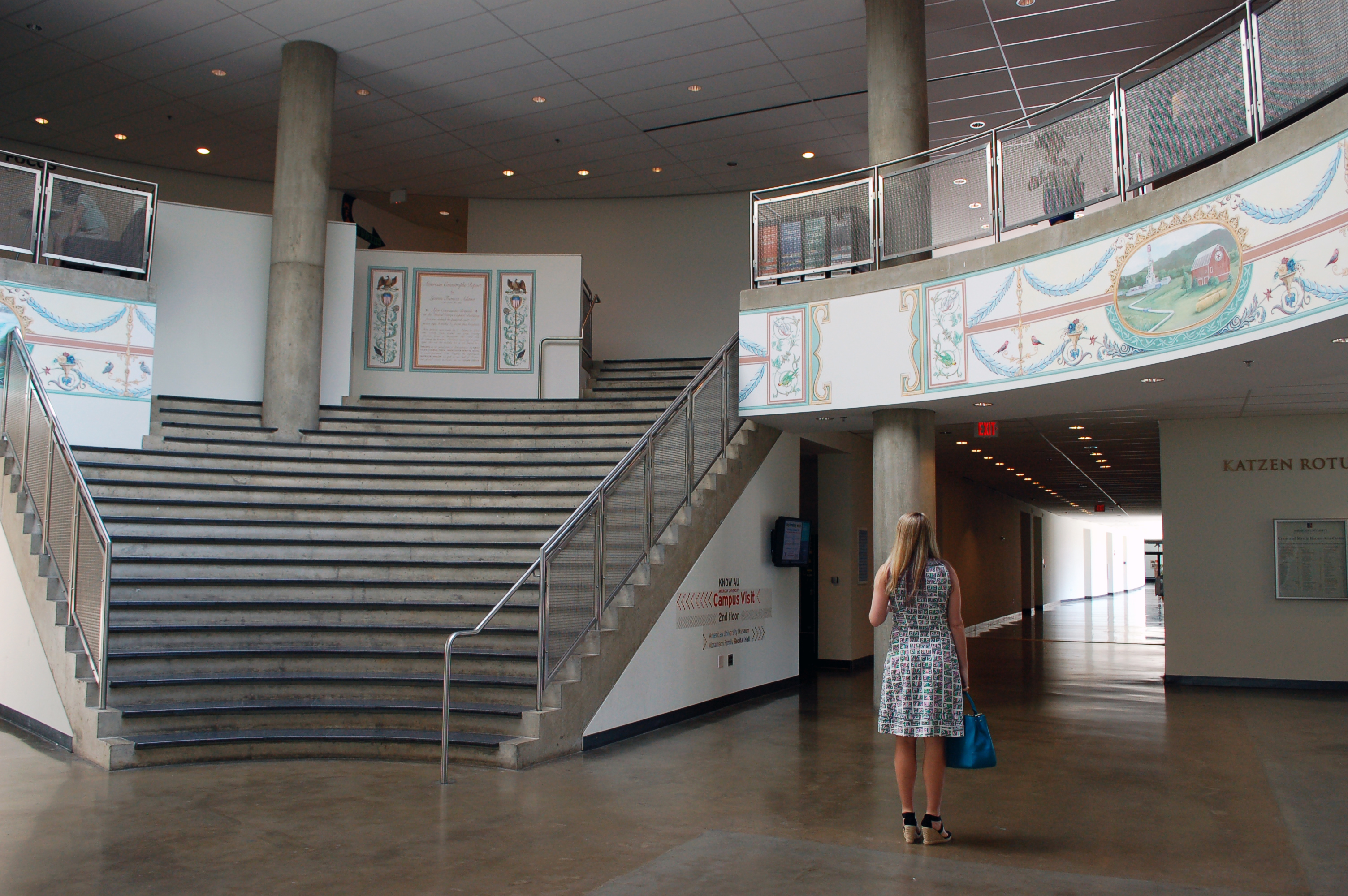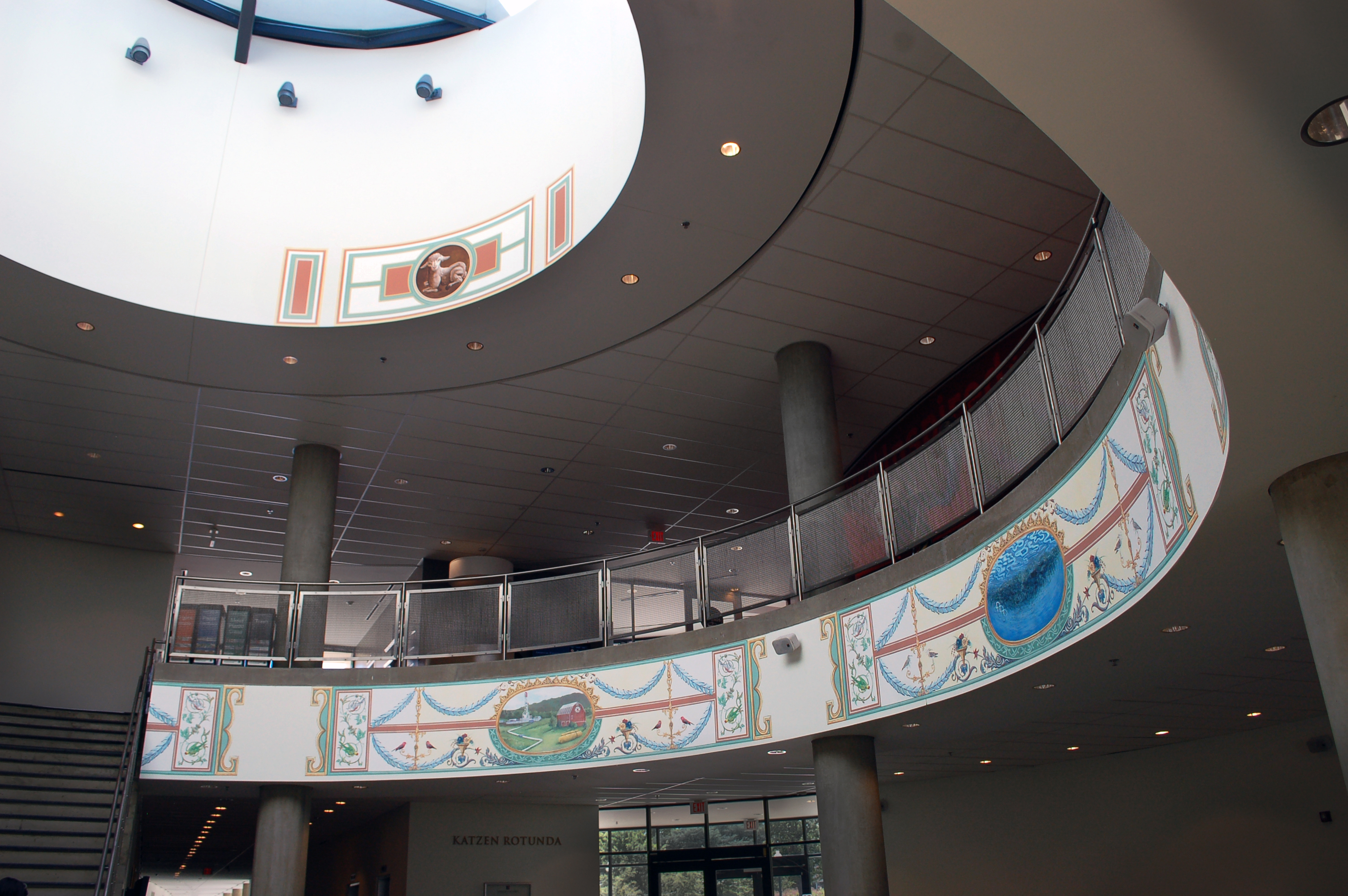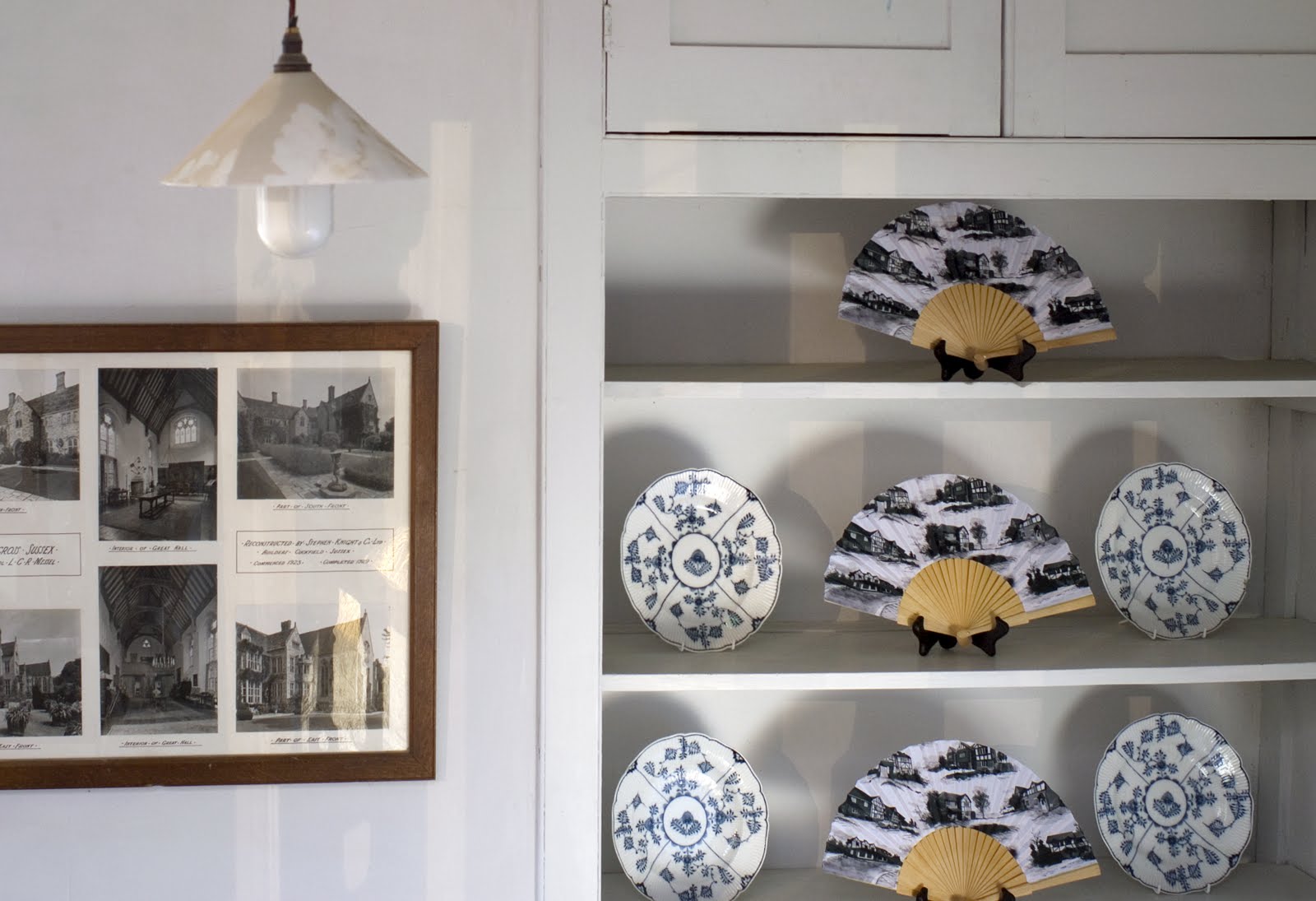About Lauren
Baltimore City
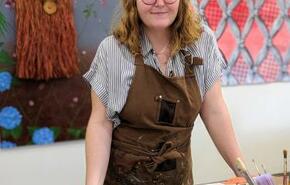
Lauren Frances Adams is a painter who lives and works in Baltimore. She earned her BFA at University of North Carolina-Chapel Hill, and her MFA at Carnegie Mellon University. She grew up in Snow Hill, North Carolina on a pig farm. Her work engages political and social histories through iconic images and domestic ornament. Her work has been exhibited across the United States at museums, university galleries, and artist-run spaces, with an upcoming 2021 project at the… more
Jump to a project:
We the People
WE THE PEOPLE, a new solo project for Expo Chicago/2012 at the Navy Pier, September 19 – 24, 2012.
Lauren Adams: We the People is organized by the Contemporary Art Museum St. Louis (CAM) and curated by Kelly Shindler, Assistant Curator.
Lauren Adams’s work addresses historical issues of colonialism—the system by which the people of one territory establish systems of authority or control over people in another territory—and industrialization to demonstrate how they inform our present-day reality. Working in a variety of media from painting and drawing to textiles and printmaking, she repurposes centuries-old imagery to explore the relationship between labor and the production of material goods. Adams uses specific images, symbols, and situations from these histories to suggest how they play a significant role in the balance of power between social classes, nations, and ethnicities today.
We the People is an interactive installation in which the artist has painted slogans from recent Occupy Wall Street and Tea Party protests into reproduced Revolutionary War-era wallpaper. The pattern, entitled “General Samuel McClellan,” features a repeated image of various everyday objects from the 18th-century. Extracted and abstracted from its original context, the protest language visible on the wallpaper functions as a generalized call to action. Visitors to CAM’s booth can record their own “protest” on a unique ceramic plate to be displayed during the fair. A custom-designed tea towel made exclusively for Expo Chicago both advertises the project and is exchanged with visitors in return for their contributions.
Lauren Adams: We the People is organized by the Contemporary Art Museum St. Louis (CAM) and curated by Kelly Shindler, Assistant Curator.
Lauren Adams’s work addresses historical issues of colonialism—the system by which the people of one territory establish systems of authority or control over people in another territory—and industrialization to demonstrate how they inform our present-day reality. Working in a variety of media from painting and drawing to textiles and printmaking, she repurposes centuries-old imagery to explore the relationship between labor and the production of material goods. Adams uses specific images, symbols, and situations from these histories to suggest how they play a significant role in the balance of power between social classes, nations, and ethnicities today.
We the People is an interactive installation in which the artist has painted slogans from recent Occupy Wall Street and Tea Party protests into reproduced Revolutionary War-era wallpaper. The pattern, entitled “General Samuel McClellan,” features a repeated image of various everyday objects from the 18th-century. Extracted and abstracted from its original context, the protest language visible on the wallpaper functions as a generalized call to action. Visitors to CAM’s booth can record their own “protest” on a unique ceramic plate to be displayed during the fair. A custom-designed tea towel made exclusively for Expo Chicago both advertises the project and is exchanged with visitors in return for their contributions.
-
 We the PeopleWe the People 2012 EXPO Chicago at the Navy Pier A solo booth presentation with the Contemporary Art Museum St. Louis We the People is an interactive installation in which the artist has painted slogans from recent Occupy Wall Street and Tea Party protests into reproduced Revolutionary War-era wallpaper. Visitors to the booth can record their own “protest” on a unique ceramic plate to be displayed during the fair. A custom-designed tea towel made exclusively for Expo Chicago both advertises the project and is exchanged with visitors in return for their contributions.
We the PeopleWe the People 2012 EXPO Chicago at the Navy Pier A solo booth presentation with the Contemporary Art Museum St. Louis We the People is an interactive installation in which the artist has painted slogans from recent Occupy Wall Street and Tea Party protests into reproduced Revolutionary War-era wallpaper. Visitors to the booth can record their own “protest” on a unique ceramic plate to be displayed during the fair. A custom-designed tea towel made exclusively for Expo Chicago both advertises the project and is exchanged with visitors in return for their contributions. -
 We the PeopleWe the People 2012 EXPO Chicago at the Navy Pier A solo booth presentation with the Contemporary Art Museum St. Louis We the People is an interactive installation in which the artist has painted slogans from recent Occupy Wall Street and Tea Party protests into reproduced Revolutionary War-era wallpaper. Visitors to the booth can record their own “protest” on a unique ceramic plate to be displayed during the fair. A custom-designed tea towel made exclusively for Expo Chicago both advertises the project and is exchanged with visitors in return for their contributions.
We the PeopleWe the People 2012 EXPO Chicago at the Navy Pier A solo booth presentation with the Contemporary Art Museum St. Louis We the People is an interactive installation in which the artist has painted slogans from recent Occupy Wall Street and Tea Party protests into reproduced Revolutionary War-era wallpaper. Visitors to the booth can record their own “protest” on a unique ceramic plate to be displayed during the fair. A custom-designed tea towel made exclusively for Expo Chicago both advertises the project and is exchanged with visitors in return for their contributions. -
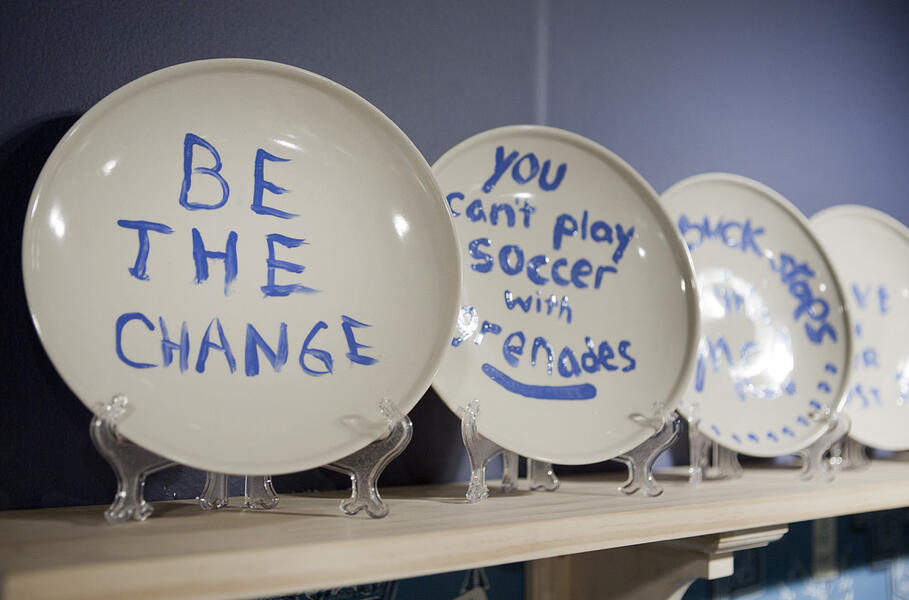 We the PeopleWe the People 2012 EXPO Chicago at the Navy Pier A solo booth presentation with the Contemporary Art Museum St. Louis We the People is an interactive installation in which the artist has painted slogans from recent Occupy Wall Street and Tea Party protests into reproduced Revolutionary War-era wallpaper. Visitors to the booth can record their own “protest” on a unique ceramic plate to be displayed during the fair. A custom-designed tea towel made exclusively for Expo Chicago both advertises the project and is exchanged with visitors in return for their contributions.
We the PeopleWe the People 2012 EXPO Chicago at the Navy Pier A solo booth presentation with the Contemporary Art Museum St. Louis We the People is an interactive installation in which the artist has painted slogans from recent Occupy Wall Street and Tea Party protests into reproduced Revolutionary War-era wallpaper. Visitors to the booth can record their own “protest” on a unique ceramic plate to be displayed during the fair. A custom-designed tea towel made exclusively for Expo Chicago both advertises the project and is exchanged with visitors in return for their contributions. -
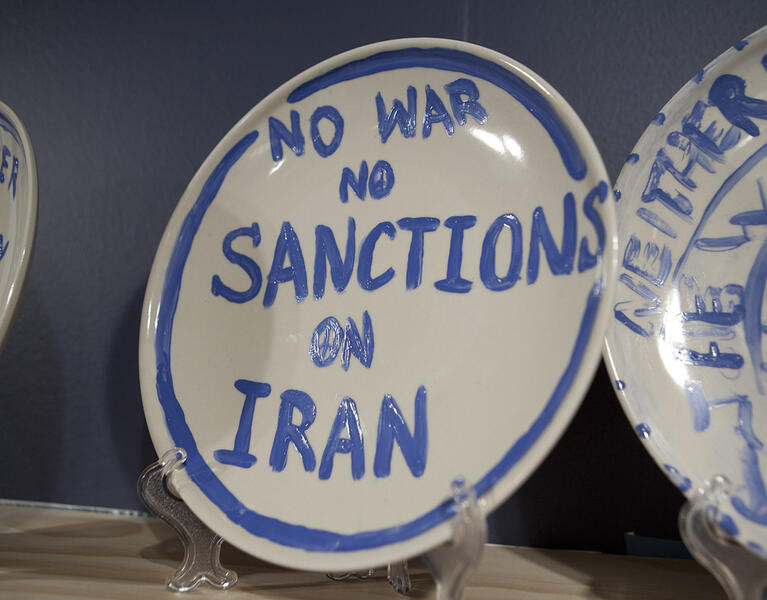 We the PeopleWe the People 2012 EXPO Chicago at the Navy Pier A solo booth presentation with the Contemporary Art Museum St. Louis We the People is an interactive installation in which the artist has painted slogans from recent Occupy Wall Street and Tea Party protests into reproduced Revolutionary War-era wallpaper. Visitors to the booth can record their own “protest” on a unique ceramic plate to be displayed during the fair. A custom-designed tea towel made exclusively for Expo Chicago both advertises the project and is exchanged with visitors in return for their contributions.
We the PeopleWe the People 2012 EXPO Chicago at the Navy Pier A solo booth presentation with the Contemporary Art Museum St. Louis We the People is an interactive installation in which the artist has painted slogans from recent Occupy Wall Street and Tea Party protests into reproduced Revolutionary War-era wallpaper. Visitors to the booth can record their own “protest” on a unique ceramic plate to be displayed during the fair. A custom-designed tea towel made exclusively for Expo Chicago both advertises the project and is exchanged with visitors in return for their contributions. -
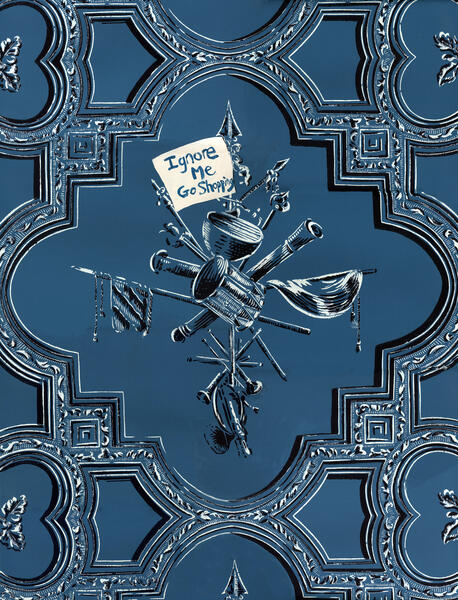 We the PeopleWe the People 2012 EXPO Chicago at the Navy Pier A solo booth presentation with the Contemporary Art Museum St. Louis We the People is an interactive installation in which the artist has painted slogans from recent Occupy Wall Street and Tea Party protests into reproduced Revolutionary War-era wallpaper. Visitors to the booth can record their own “protest” on a unique ceramic plate to be displayed during the fair. A custom-designed tea towel made exclusively for Expo Chicago both advertises the project and is exchanged with visitors in return for their contributions.
We the PeopleWe the People 2012 EXPO Chicago at the Navy Pier A solo booth presentation with the Contemporary Art Museum St. Louis We the People is an interactive installation in which the artist has painted slogans from recent Occupy Wall Street and Tea Party protests into reproduced Revolutionary War-era wallpaper. Visitors to the booth can record their own “protest” on a unique ceramic plate to be displayed during the fair. A custom-designed tea towel made exclusively for Expo Chicago both advertises the project and is exchanged with visitors in return for their contributions. -
 We the PeopleWe the People 2012 EXPO Chicago at the Navy Pier A solo booth presentation with the Contemporary Art Museum St. Louis We the People is an interactive installation in which the artist has painted slogans from recent Occupy Wall Street and Tea Party protests into reproduced Revolutionary War-era wallpaper. Visitors to the booth can record their own “protest” on a unique ceramic plate to be displayed during the fair. A custom-designed tea towel made exclusively for Expo Chicago both advertises the project and is exchanged with visitors in return for their contributions.
We the PeopleWe the People 2012 EXPO Chicago at the Navy Pier A solo booth presentation with the Contemporary Art Museum St. Louis We the People is an interactive installation in which the artist has painted slogans from recent Occupy Wall Street and Tea Party protests into reproduced Revolutionary War-era wallpaper. Visitors to the booth can record their own “protest” on a unique ceramic plate to be displayed during the fair. A custom-designed tea towel made exclusively for Expo Chicago both advertises the project and is exchanged with visitors in return for their contributions. -
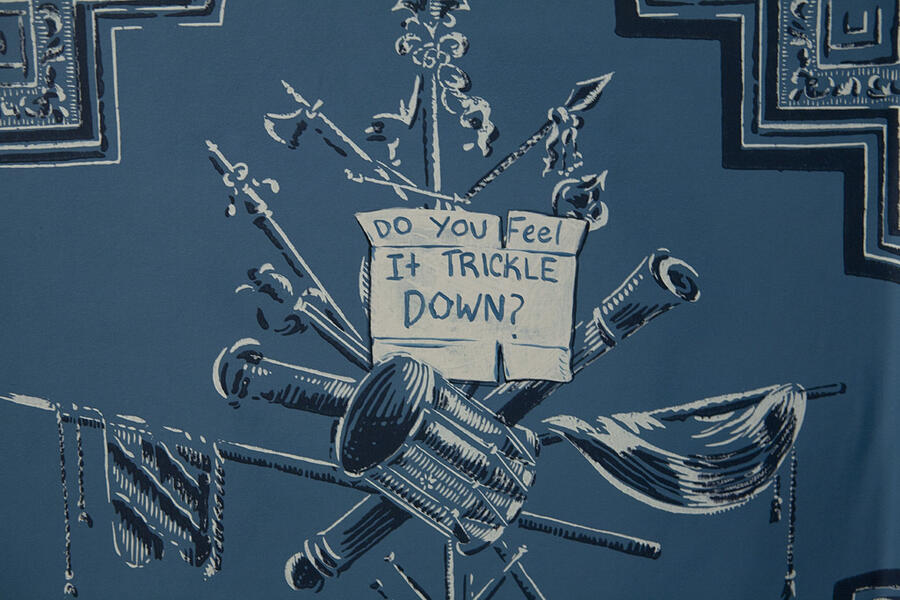 We the PeopleWe the People 2012 EXPO Chicago at the Navy Pier A solo booth presentation with the Contemporary Art Museum St. Louis We the People is an interactive installation in which the artist has painted slogans from recent Occupy Wall Street and Tea Party protests into reproduced Revolutionary War-era wallpaper. Visitors to the booth can record their own “protest” on a unique ceramic plate to be displayed during the fair. A custom-designed tea towel made exclusively for Expo Chicago both advertises the project and is exchanged with visitors in return for their contributions.
We the PeopleWe the People 2012 EXPO Chicago at the Navy Pier A solo booth presentation with the Contemporary Art Museum St. Louis We the People is an interactive installation in which the artist has painted slogans from recent Occupy Wall Street and Tea Party protests into reproduced Revolutionary War-era wallpaper. Visitors to the booth can record their own “protest” on a unique ceramic plate to be displayed during the fair. A custom-designed tea towel made exclusively for Expo Chicago both advertises the project and is exchanged with visitors in return for their contributions. -
 We the PeopleWe the People 2012 EXPO Chicago at the Navy Pier A solo booth presentation with the Contemporary Art Museum St. Louis We the People is an interactive installation in which the artist has painted slogans from recent Occupy Wall Street and Tea Party protests into reproduced Revolutionary War-era wallpaper. Visitors to the booth can record their own “protest” on a unique ceramic plate to be displayed during the fair. A custom-designed tea towel made exclusively for Expo Chicago both advertises the project and is exchanged with visitors in return for their contributions.
We the PeopleWe the People 2012 EXPO Chicago at the Navy Pier A solo booth presentation with the Contemporary Art Museum St. Louis We the People is an interactive installation in which the artist has painted slogans from recent Occupy Wall Street and Tea Party protests into reproduced Revolutionary War-era wallpaper. Visitors to the booth can record their own “protest” on a unique ceramic plate to be displayed during the fair. A custom-designed tea towel made exclusively for Expo Chicago both advertises the project and is exchanged with visitors in return for their contributions. -
 We the PeopleWe the People 2012 EXPO Chicago at the Navy Pier A solo booth presentation with the Contemporary Art Museum St. Louis We the People is an interactive installation in which the artist has painted slogans from recent Occupy Wall Street and Tea Party protests into reproduced Revolutionary War-era wallpaper. Visitors to the booth can record their own “protest” on a unique ceramic plate to be displayed during the fair. A custom-designed tea towel made exclusively for Expo Chicago both advertises the project and is exchanged with visitors in return for their contributions.
We the PeopleWe the People 2012 EXPO Chicago at the Navy Pier A solo booth presentation with the Contemporary Art Museum St. Louis We the People is an interactive installation in which the artist has painted slogans from recent Occupy Wall Street and Tea Party protests into reproduced Revolutionary War-era wallpaper. Visitors to the booth can record their own “protest” on a unique ceramic plate to be displayed during the fair. A custom-designed tea towel made exclusively for Expo Chicago both advertises the project and is exchanged with visitors in return for their contributions. -
 We the PeopleWe the People 2012 EXPO Chicago at the Navy Pier A solo booth presentation with the Contemporary Art Museum St. Louis We the People is an interactive installation in which the artist has painted slogans from recent Occupy Wall Street and Tea Party protests into reproduced Revolutionary War-era wallpaper. Visitors to the booth can record their own “protest” on a unique ceramic plate to be displayed during the fair. A custom-designed tea towel made exclusively for Expo Chicago both advertises the project and is exchanged with visitors in return for their contributions.
We the PeopleWe the People 2012 EXPO Chicago at the Navy Pier A solo booth presentation with the Contemporary Art Museum St. Louis We the People is an interactive installation in which the artist has painted slogans from recent Occupy Wall Street and Tea Party protests into reproduced Revolutionary War-era wallpaper. Visitors to the booth can record their own “protest” on a unique ceramic plate to be displayed during the fair. A custom-designed tea towel made exclusively for Expo Chicago both advertises the project and is exchanged with visitors in return for their contributions.
Precarious Prototypes
I began this project in search of objects in The Walters Museum collection that depicted enslaved peoples. Expanding my inquiry into the museum as labor archive, Precarious Prototypes ultimately explores the mannered representations of servitude and objectification within the museum’s collection. Select objects are exhibited as well as printed, to understand and unsettle the role of the museum as master narrator. And so, the drapery both reveals and conceals, becoming an index of unstable contradictions. Specifically, I am looking at how depictions of the body as subservient, contorted, dehumanized, grotesque and lacking agency, unravel how art history becomes art as history.
As installed at the Walters Museum, with textiles of the artist's design as well as museum objects.
As installed at the Walters Museum, with textiles of the artist's design as well as museum objects.
-
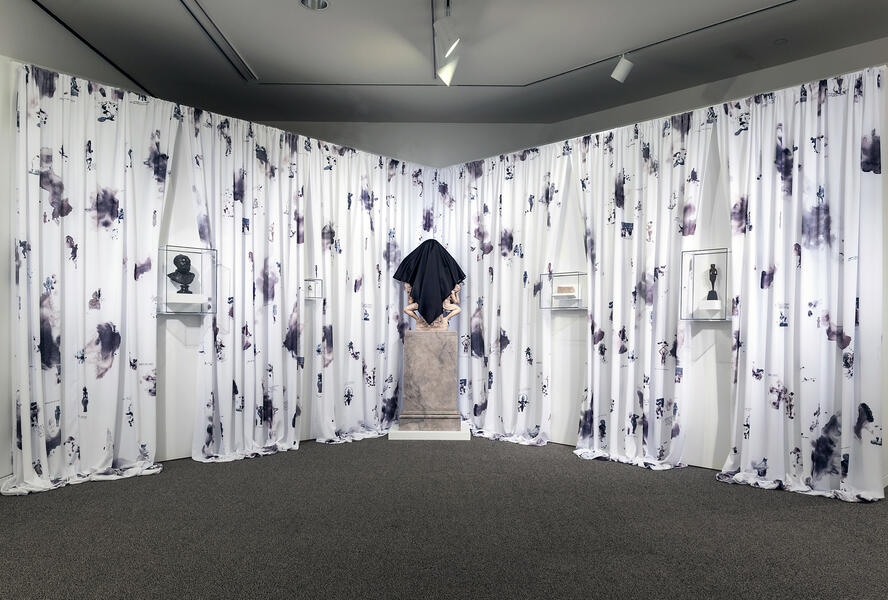 Precarious PrototypesPrecarious Prototypes, a textile installation that responds to and transforms selected objects from the Walters Art Museum’s collection.
Precarious PrototypesPrecarious Prototypes, a textile installation that responds to and transforms selected objects from the Walters Art Museum’s collection. -
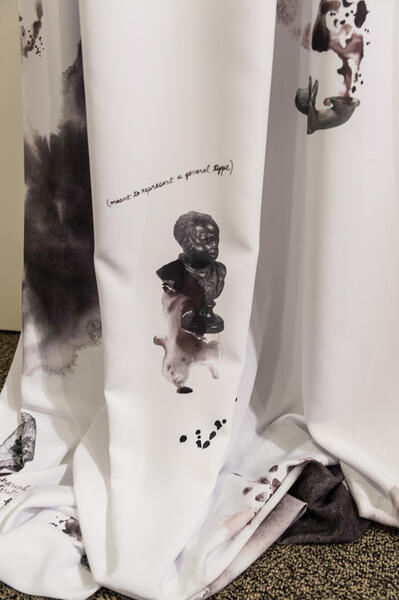 Precarious PrototypesPrecarious Prototypes, a textile installation that responds to and transforms selected objects from the Walters Art Museum’s collection.
Precarious PrototypesPrecarious Prototypes, a textile installation that responds to and transforms selected objects from the Walters Art Museum’s collection. -
 Precarious PrototypesPrecarious Prototypes, a textile installation that responds to and transforms selected objects from the Walters Art Museum’s collection.
Precarious PrototypesPrecarious Prototypes, a textile installation that responds to and transforms selected objects from the Walters Art Museum’s collection. -
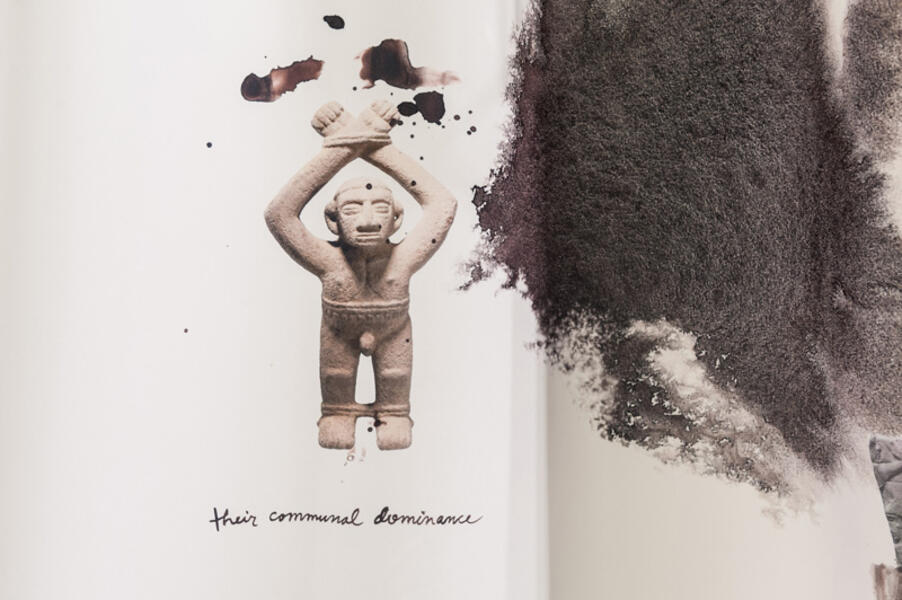 Precarious PrototypesPrecarious Prototypes, a textile installation that responds to and transforms selected objects from the Walters Art Museum’s collection.
Precarious PrototypesPrecarious Prototypes, a textile installation that responds to and transforms selected objects from the Walters Art Museum’s collection. -
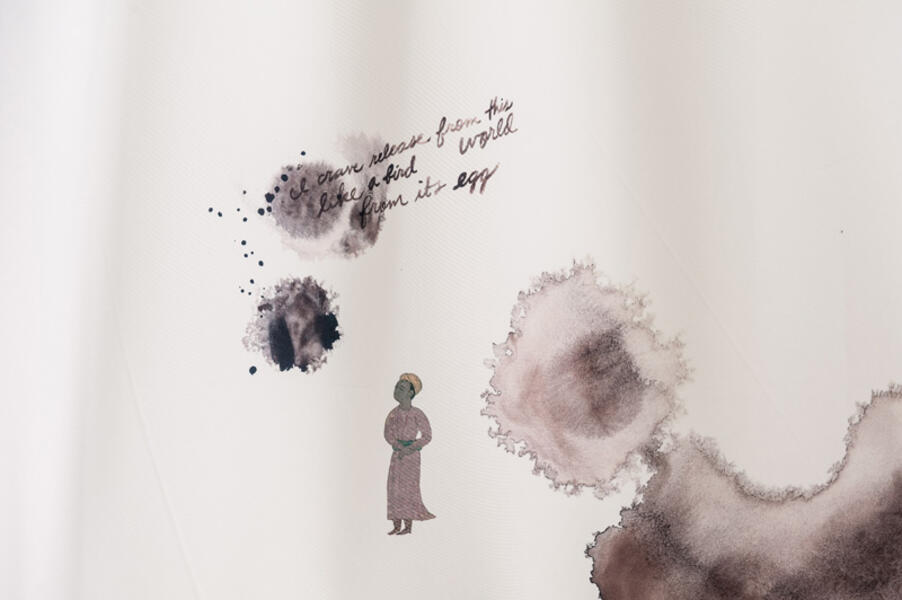 la-2014-08-11-044.jpgPrecarious Prototypes, a textile installation that responds to and transforms selected objects from the Walters Art Museum’s collection.
la-2014-08-11-044.jpgPrecarious Prototypes, a textile installation that responds to and transforms selected objects from the Walters Art Museum’s collection. -
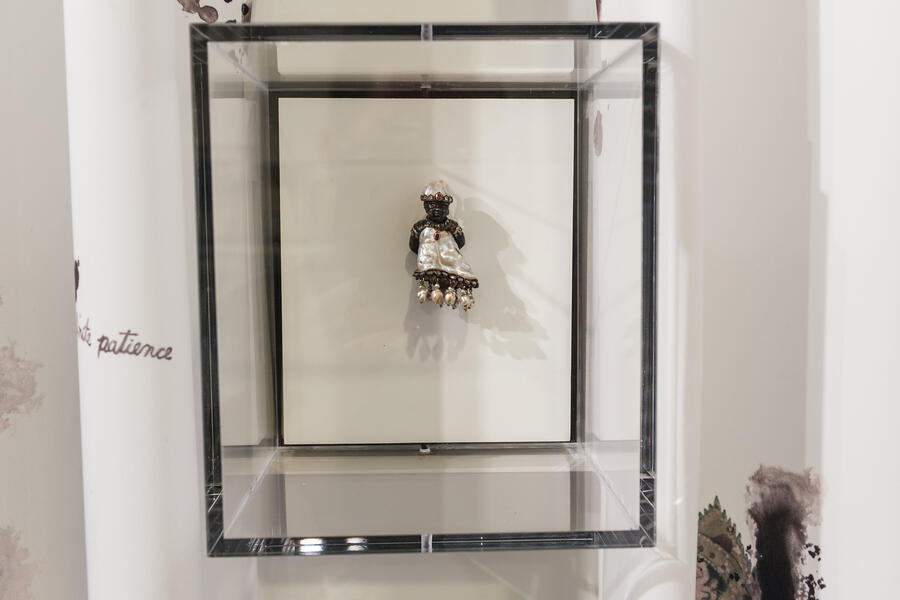 Precarious PrototypesPrecarious Prototypes, a textile installation that responds to and transforms selected objects from the Walters Art Museum’s collection.
Precarious PrototypesPrecarious Prototypes, a textile installation that responds to and transforms selected objects from the Walters Art Museum’s collection. -
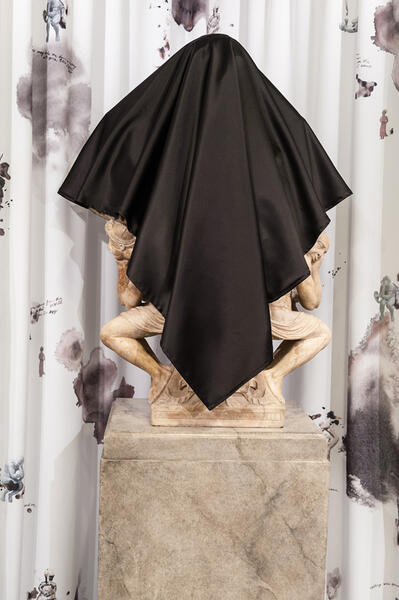 Precarious PrototypesPrecarious Prototypes, a textile installation that responds to and transforms selected objects from the Walters Art Museum’s collection.
Precarious PrototypesPrecarious Prototypes, a textile installation that responds to and transforms selected objects from the Walters Art Museum’s collection. -
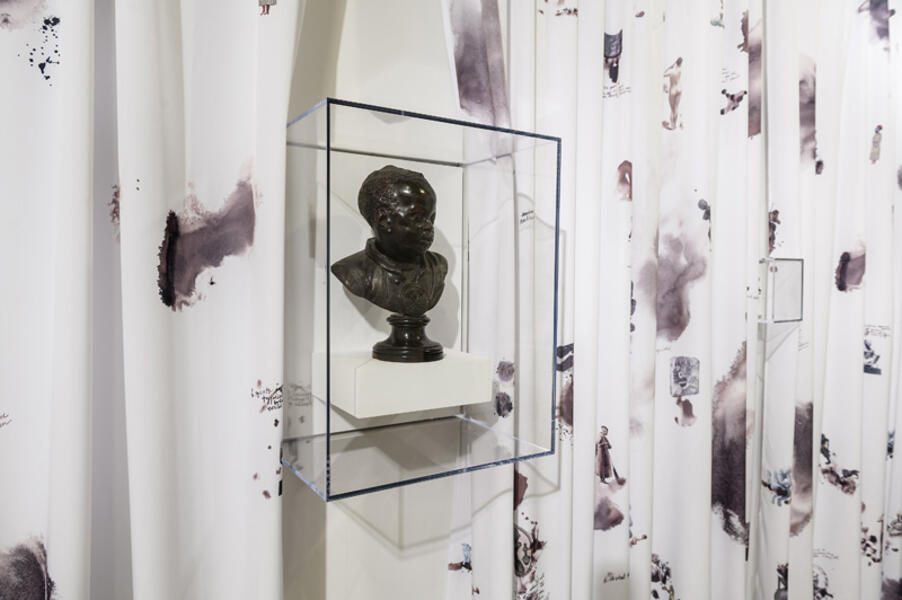 Precarious PrototypesPrecarious Prototypes, a textile installation that responds to and transforms selected objects from the Walters Art Museum’s collection.
Precarious PrototypesPrecarious Prototypes, a textile installation that responds to and transforms selected objects from the Walters Art Museum’s collection. -
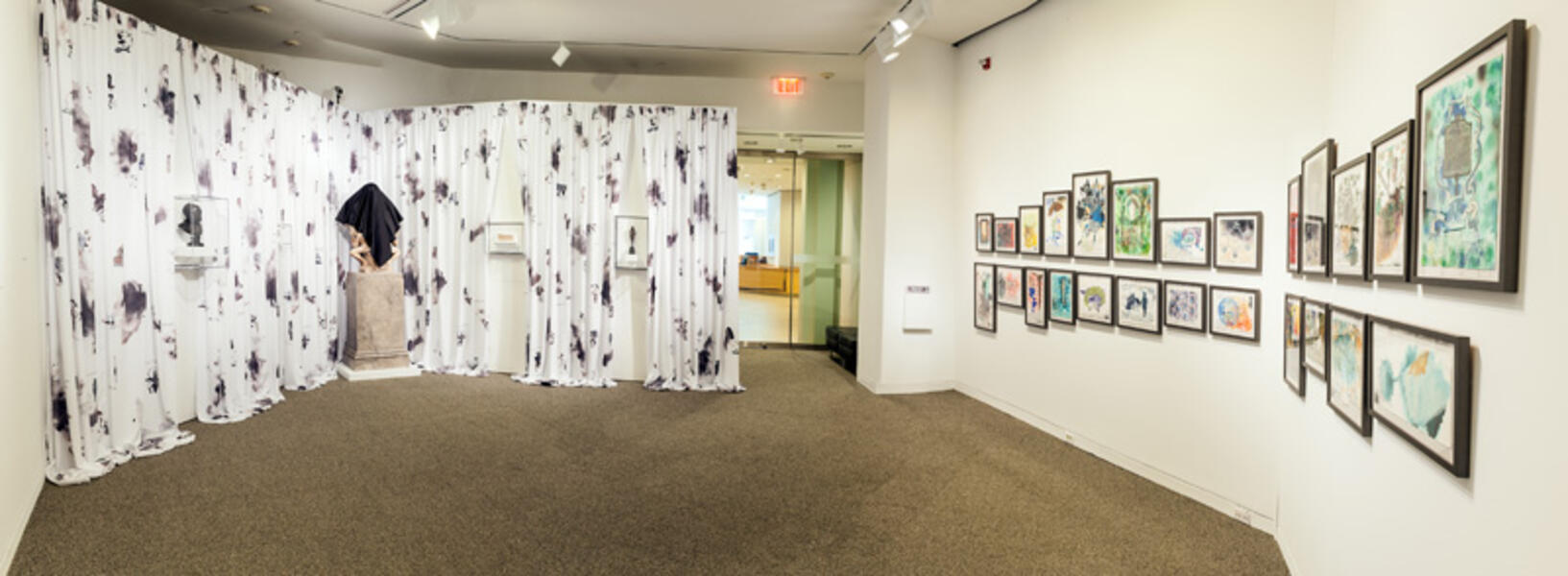 Precarious PrototypesPrecarious Prototypes, a textile installation that responds to and transforms selected objects from the Walters Art Museum’s collection. shown also with Decorum, as installed at the Walters Art Museum
Precarious PrototypesPrecarious Prototypes, a textile installation that responds to and transforms selected objects from the Walters Art Museum’s collection. shown also with Decorum, as installed at the Walters Art Museum -
 Precarious PrototypesDecorum, as installed at the Walters Art Museum, 2014
Precarious PrototypesDecorum, as installed at the Walters Art Museum, 2014
American Catastrophe Report
September 1, 2014 - May 2015
Washington, D.C.
Artist Lauren Frances Adams has created American Catastrophe Report, an installation that acts as both homage and critique of the decorative frescoes in the United States Capitol Building, originally painted in the 19th c. by Italian-born artist Constantino Brumidi. The site-specific artwork by Adams is installed in American University’s Katzen Arts Center, in both the upper and lower rotunda in the center of the building, less than six miles from where Brumidi’s paintings are located. The prints forming American Catastrophe Report have the appearance of paintings due to the unique process Adams uses, where hand-painted originals are digitally scanned then printed for long-term public display. Adams updates Brumidi’s Capitol ornamentation by directly addressing ecological disasters in America that have been caused by human activities.
Visitors to the Katzen Arts Center will see an installation that is a mix of appropriated and invented imagery. Adams adapts Brumidi’s original frescoes in the U.S. Senate Wing that picture landscapes of the sparsely populated western states of the mid-19th century, as well as a variety of detailed images of birds. According to historians, Brumidi copied from lithographs in the Pacific Railroad Report and the Mexican Boundary Report, published in the 1850’s. It is possible that Brumidi’s incorporation of these landscapes were intended to not only celebrate scenic visions of America but also to promote a comprehensive identity of American geography and inevitable settlement. Further promoting specificity of place, the birds pictured in the Senate wing point to the importance of uniquely American subject matter in Brumidi’s efforts. Assistant curator for the Office of Senate Curator, Amy Elizabeth Burton, writes about the time capsule nature of the paintings, stating in the catalogue (published in 2014) To Make Beautiful the Capitol: Rediscovering the Art of Constantino Brumidi, “Brumidi’s birds reflect the 19-century surge in westward expansion and federal support for exploration and scientific discovery across the young and developing nation.”
Extending and celebrating this act of copying, Lauren Frances Adams has updated Brumidi’s masterful efforts with similar themes -- landscapes and ornithological images -- but with a decidedly different artistic outcome. Reflecting a century and a half of human enterprise since Brumidi’s time, a selection of landscapes in decorative cartouches offers up these situations: Fracking (in rural Pennsylvania), the Great Pacific Garbage Patch, Mountaintop Removal Mining (in West Virginia), the Deepwater Horizon Oil Spill (in the Gulf of Mexico), and Climate Change (specified as glacial retreat in Alaska). Corresponding to each man-made ecological disaster, and pointing towards the totalizing effects of habitat destruction, pollution via chemicals and garbage, and changes in weather conditions, Adams has included several birds that represent the threats to fauna as environmental destruction advances: Scarlet Tanager, Bristle-Thighed Curlew, Cerulean Warbler, Brown Pelican, and the Tufted Puffin.
Other imagery present throughout the rotunda gives depth to the historical relationships between American citizens and our physical landscape. Acting as symbolic prescience, ornamental designs incorporate two birds distinctly absent from America today: the Carolina Parakeet and the Passenger Pigeon, both extinct. Decorative flora in the paintings incorporates kudzu, a non-native species that has caused widespread ecological damage in the United States. Other imagery near the project signage incorporates invasive species in North America: Africanized bee, Common Starling, Nutria, Cabbage White butterfly, and the Emerald Ash Borer. Lofted high above, two medallions face one another in the upper rotunda: a war-like eagle and a gentle lamb. Utilizing the neoclassical aesthetic employed by Constantino Brumidi (who was in turn inspired by ornamental Renaissance paintings in the Vatican), Adams incorporates uniquely American identifications, inviting visitors to the American University Katzen Arts Center to reflect upon the conundrum of the contemporary American condition visualized in American Catastrophe Report.
Washington, D.C.
Artist Lauren Frances Adams has created American Catastrophe Report, an installation that acts as both homage and critique of the decorative frescoes in the United States Capitol Building, originally painted in the 19th c. by Italian-born artist Constantino Brumidi. The site-specific artwork by Adams is installed in American University’s Katzen Arts Center, in both the upper and lower rotunda in the center of the building, less than six miles from where Brumidi’s paintings are located. The prints forming American Catastrophe Report have the appearance of paintings due to the unique process Adams uses, where hand-painted originals are digitally scanned then printed for long-term public display. Adams updates Brumidi’s Capitol ornamentation by directly addressing ecological disasters in America that have been caused by human activities.
Visitors to the Katzen Arts Center will see an installation that is a mix of appropriated and invented imagery. Adams adapts Brumidi’s original frescoes in the U.S. Senate Wing that picture landscapes of the sparsely populated western states of the mid-19th century, as well as a variety of detailed images of birds. According to historians, Brumidi copied from lithographs in the Pacific Railroad Report and the Mexican Boundary Report, published in the 1850’s. It is possible that Brumidi’s incorporation of these landscapes were intended to not only celebrate scenic visions of America but also to promote a comprehensive identity of American geography and inevitable settlement. Further promoting specificity of place, the birds pictured in the Senate wing point to the importance of uniquely American subject matter in Brumidi’s efforts. Assistant curator for the Office of Senate Curator, Amy Elizabeth Burton, writes about the time capsule nature of the paintings, stating in the catalogue (published in 2014) To Make Beautiful the Capitol: Rediscovering the Art of Constantino Brumidi, “Brumidi’s birds reflect the 19-century surge in westward expansion and federal support for exploration and scientific discovery across the young and developing nation.”
Extending and celebrating this act of copying, Lauren Frances Adams has updated Brumidi’s masterful efforts with similar themes -- landscapes and ornithological images -- but with a decidedly different artistic outcome. Reflecting a century and a half of human enterprise since Brumidi’s time, a selection of landscapes in decorative cartouches offers up these situations: Fracking (in rural Pennsylvania), the Great Pacific Garbage Patch, Mountaintop Removal Mining (in West Virginia), the Deepwater Horizon Oil Spill (in the Gulf of Mexico), and Climate Change (specified as glacial retreat in Alaska). Corresponding to each man-made ecological disaster, and pointing towards the totalizing effects of habitat destruction, pollution via chemicals and garbage, and changes in weather conditions, Adams has included several birds that represent the threats to fauna as environmental destruction advances: Scarlet Tanager, Bristle-Thighed Curlew, Cerulean Warbler, Brown Pelican, and the Tufted Puffin.
Other imagery present throughout the rotunda gives depth to the historical relationships between American citizens and our physical landscape. Acting as symbolic prescience, ornamental designs incorporate two birds distinctly absent from America today: the Carolina Parakeet and the Passenger Pigeon, both extinct. Decorative flora in the paintings incorporates kudzu, a non-native species that has caused widespread ecological damage in the United States. Other imagery near the project signage incorporates invasive species in North America: Africanized bee, Common Starling, Nutria, Cabbage White butterfly, and the Emerald Ash Borer. Lofted high above, two medallions face one another in the upper rotunda: a war-like eagle and a gentle lamb. Utilizing the neoclassical aesthetic employed by Constantino Brumidi (who was in turn inspired by ornamental Renaissance paintings in the Vatican), Adams incorporates uniquely American identifications, inviting visitors to the American University Katzen Arts Center to reflect upon the conundrum of the contemporary American condition visualized in American Catastrophe Report.
-
 American Catastrophe Reportoverall installation at Katzen Arts Center through May 2015
American Catastrophe Reportoverall installation at Katzen Arts Center through May 2015 -
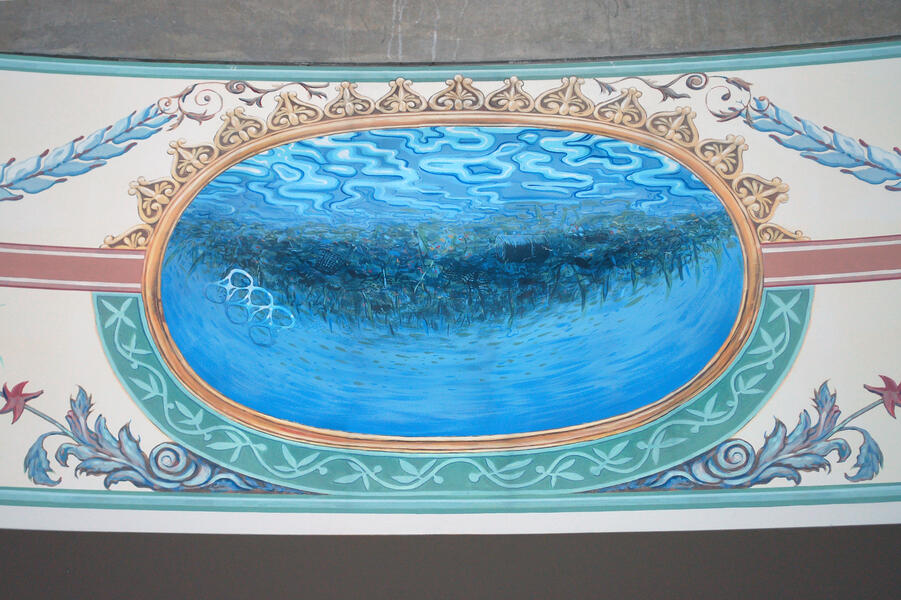 American Catastrophe Reportoverall installation at Katzen Arts Center through May 2015 showing Great Pacific Garbage Patch cartouche
American Catastrophe Reportoverall installation at Katzen Arts Center through May 2015 showing Great Pacific Garbage Patch cartouche -
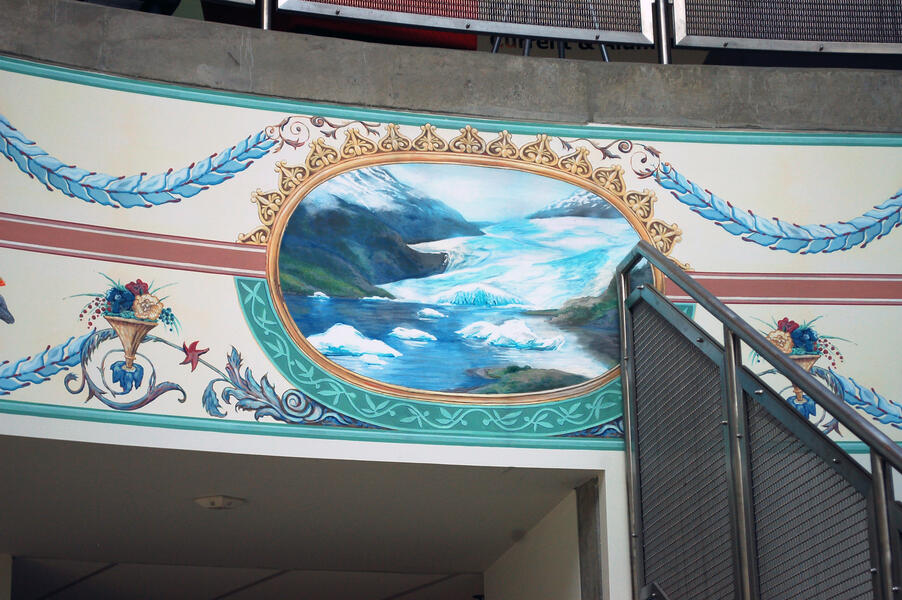 American Catastrophe Reportoverall installation at Katzen Arts Center through May 2015 showing Glacial Retreat in Alaska cartouche
American Catastrophe Reportoverall installation at Katzen Arts Center through May 2015 showing Glacial Retreat in Alaska cartouche -
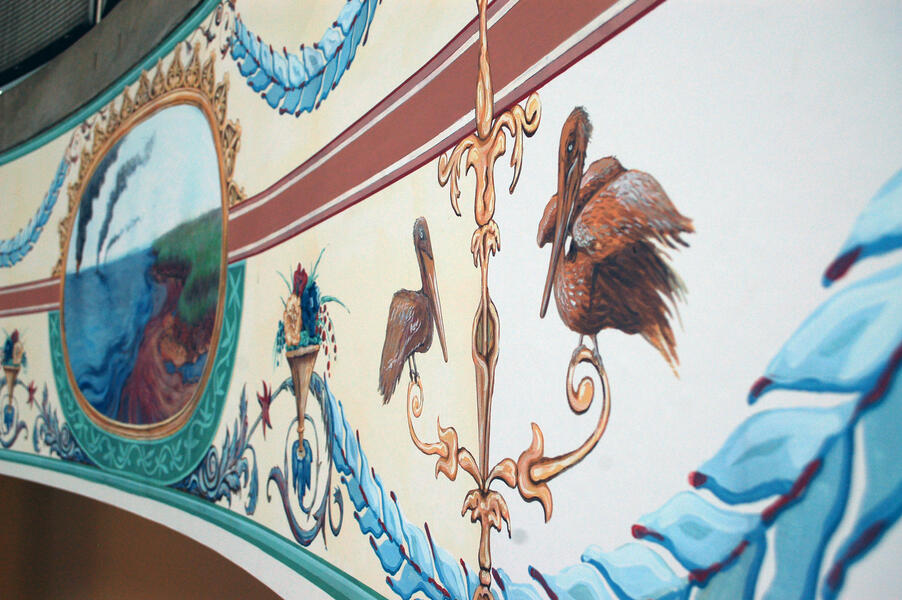 American Catastrophe Reportoverall installation at Katzen Arts Center through May 2015 showing Deepwater Horizon Oil Spill cartouche with oil-covered birds
American Catastrophe Reportoverall installation at Katzen Arts Center through May 2015 showing Deepwater Horizon Oil Spill cartouche with oil-covered birds -
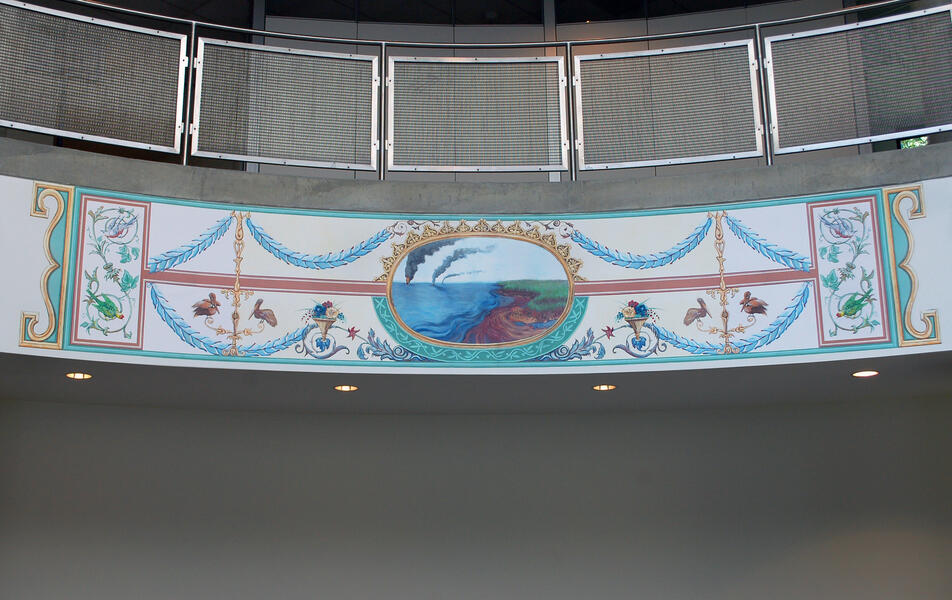 American Catastrophe ReportAmerican Catastrophe Report installation at Katzen Arts Center through 2014 - 2015 showing Deepwater Horizon Oil Spill cartouche with oil-covered birds
American Catastrophe ReportAmerican Catastrophe Report installation at Katzen Arts Center through 2014 - 2015 showing Deepwater Horizon Oil Spill cartouche with oil-covered birds -
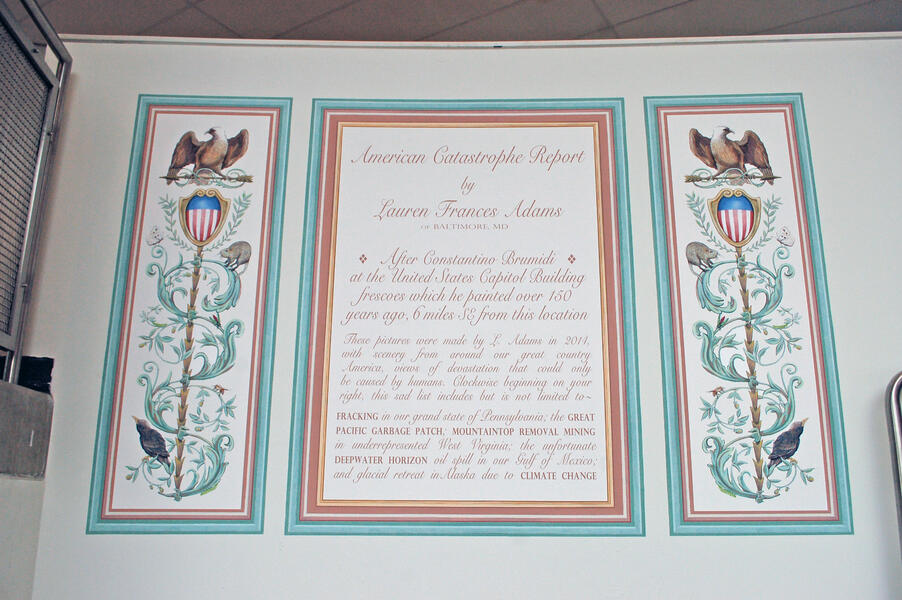 American Catastrophe Reportoverall view of signage for installation at Katzen Arts Center through May 2015 Signage details the sites shown in the 5 panels/cartouches as well as each bird included corresponding with the physical sites. Side panels show invasive species of North America.
American Catastrophe Reportoverall view of signage for installation at Katzen Arts Center through May 2015 Signage details the sites shown in the 5 panels/cartouches as well as each bird included corresponding with the physical sites. Side panels show invasive species of North America. -
 American Catastrophe Reportoverall view of installation at Katzen Arts Center through May 2015
American Catastrophe Reportoverall view of installation at Katzen Arts Center through May 2015 -
 American Catastrophe Reportdetail of Carolina Parakeets (extinct species) in the installation at Katzen Arts Center through May 2015
American Catastrophe Reportdetail of Carolina Parakeets (extinct species) in the installation at Katzen Arts Center through May 2015 -
 American Catastrophe Reportoverall installation at Katzen Arts Center through May 2015
American Catastrophe Reportoverall installation at Katzen Arts Center through May 2015 -
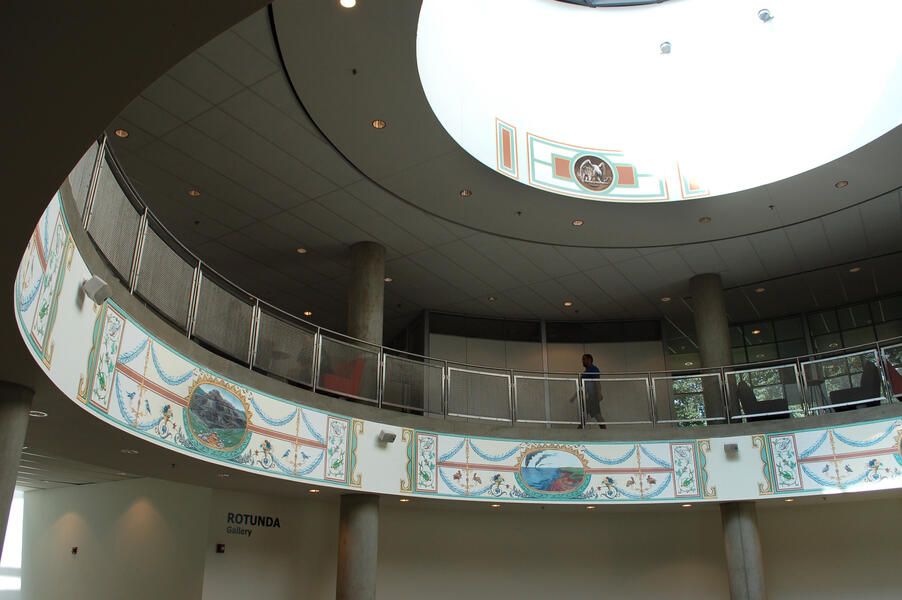 American Catastrophe Reportoverall installation at Katzen Arts Center through May 2015
American Catastrophe Reportoverall installation at Katzen Arts Center through May 2015
Grand Tour Fan
Installed at Nymans House and Gardens in West Sussex, England for the exhibition Unravelling the National Trust. Nymans House and Garden is a National Trust property known primarily for its exquisite English garden, which has been designed and developed by three generations of the Messel family. The artwork is a large-scale fan inspired by the Messel family fan collection (at the Fitzwilliam Museum, Cambridge, UK). Grand Tour Fan appropriates from the original c. 18th century Grand Tour Fan on display in Cambridge. This fan inserts intentionally banal public places from contemporary Sussex life into the historical framework -- substituting scenes of Italian ruins with those of Gatwick Airport (just a few miles from Nymans House).
-
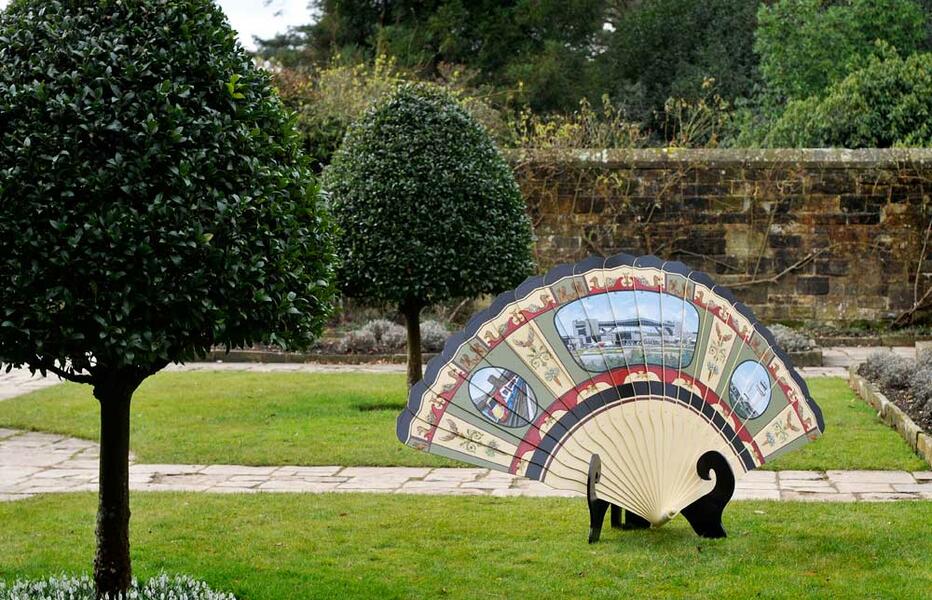 Grand Tour FanInstalled at Nymans House and Gardens in West Sussex, England for the exhibition Unravelling the National Trust. Nymans House and Garden is a National Trust property known primarily for its exquisite English garden, which has been designed and developed by three generations of the Messel family. The artwork is a large-scale fan inspired by the Messel family fan collection (at the Fitzwilliam Museum, Cambridge, UK). Grand Tour Fan appropriates from the original c. 18th century Grand Tour Fan on display in Cambridge. This fan inserts intentionally banal public places from contemporary Sussex life into the historical framework -- substituting scenes of Italian ruins with those of Gatwick Airport (just a few miles from Nymans House).
Grand Tour FanInstalled at Nymans House and Gardens in West Sussex, England for the exhibition Unravelling the National Trust. Nymans House and Garden is a National Trust property known primarily for its exquisite English garden, which has been designed and developed by three generations of the Messel family. The artwork is a large-scale fan inspired by the Messel family fan collection (at the Fitzwilliam Museum, Cambridge, UK). Grand Tour Fan appropriates from the original c. 18th century Grand Tour Fan on display in Cambridge. This fan inserts intentionally banal public places from contemporary Sussex life into the historical framework -- substituting scenes of Italian ruins with those of Gatwick Airport (just a few miles from Nymans House). -
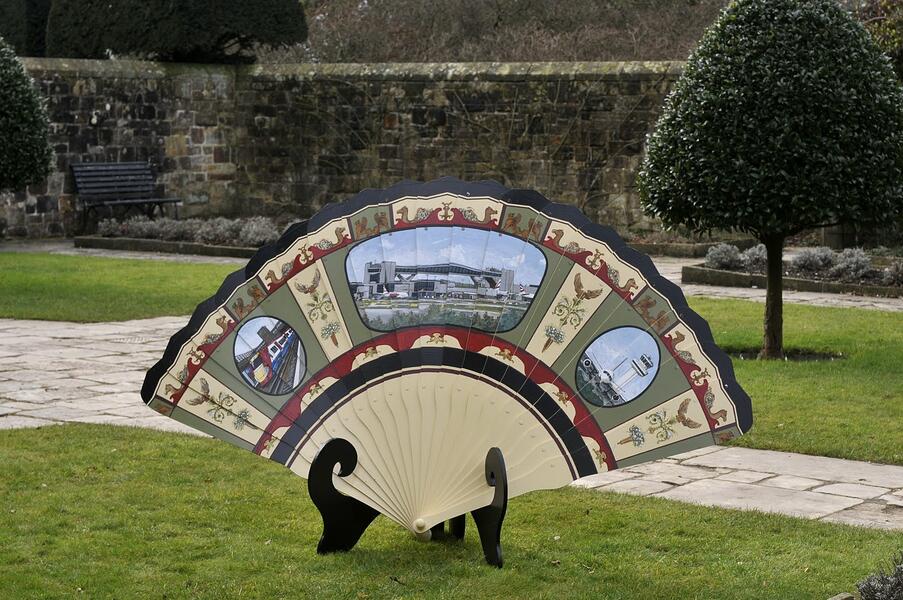 Grand Tour FanInstalled at Nymans House and Gardens in West Sussex, England for the exhibition Unravelling the National Trust. Nymans House and Garden is a National Trust property known primarily for its exquisite English garden, which has been designed and developed by three generations of the Messel family. The artwork is a large-scale fan inspired by the Messel family fan collection (at the Fitzwilliam Museum, Cambridge, UK). Grand Tour Fan appropriates from the original c. 18th century Grand Tour Fan on display in Cambridge. This fan inserts intentionally banal public places from contemporary Sussex life into the historical framework -- substituting scenes of Italian ruins with those of Gatwick Airport (just a few miles from Nymans House).
Grand Tour FanInstalled at Nymans House and Gardens in West Sussex, England for the exhibition Unravelling the National Trust. Nymans House and Garden is a National Trust property known primarily for its exquisite English garden, which has been designed and developed by three generations of the Messel family. The artwork is a large-scale fan inspired by the Messel family fan collection (at the Fitzwilliam Museum, Cambridge, UK). Grand Tour Fan appropriates from the original c. 18th century Grand Tour Fan on display in Cambridge. This fan inserts intentionally banal public places from contemporary Sussex life into the historical framework -- substituting scenes of Italian ruins with those of Gatwick Airport (just a few miles from Nymans House). -
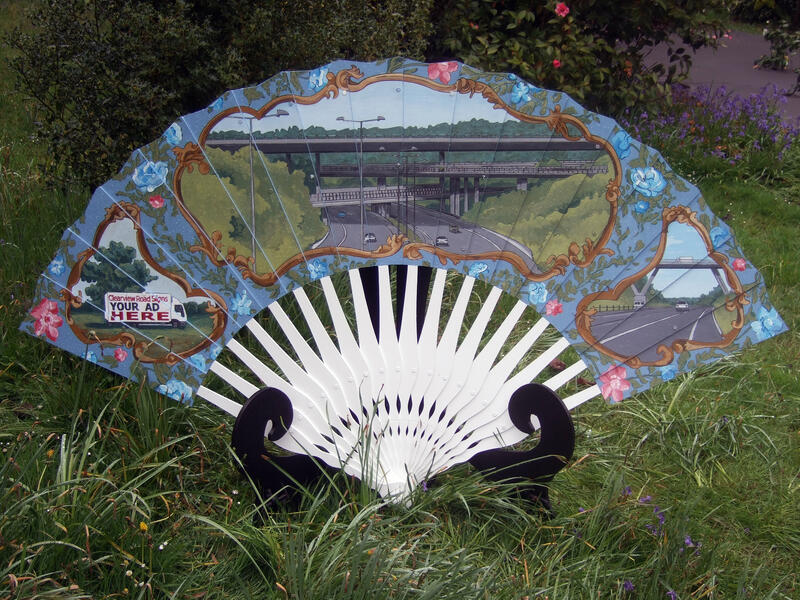 dscf0182b.jpgSecond fan on display in the Nymans House and Gardens. Road to Nymans pictures the M23 roadway, the main thoroughfare between London and Nymans, which elevates with absurd revisions of the ornamental fan scenes, challenging site-specific concepts of fantasy and utopia.
dscf0182b.jpgSecond fan on display in the Nymans House and Gardens. Road to Nymans pictures the M23 roadway, the main thoroughfare between London and Nymans, which elevates with absurd revisions of the ornamental fan scenes, challenging site-specific concepts of fantasy and utopia. -
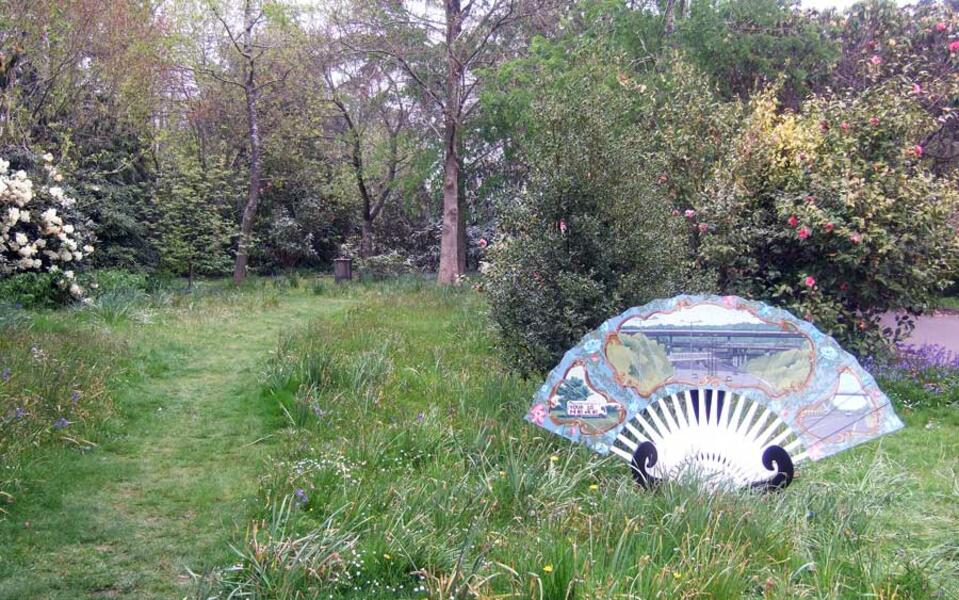 dscf0119a-900pxweb.jpgSecond fan on display in the Nymans House and Gardens. Road to Nymans pictures the M23 roadway, the main thoroughfare between London and Nymans, which elevates with absurd revisions of the ornamental fan scenes, challenging site-specific concepts of fantasy and utopia.
dscf0119a-900pxweb.jpgSecond fan on display in the Nymans House and Gardens. Road to Nymans pictures the M23 roadway, the main thoroughfare between London and Nymans, which elevates with absurd revisions of the ornamental fan scenes, challenging site-specific concepts of fantasy and utopia. -
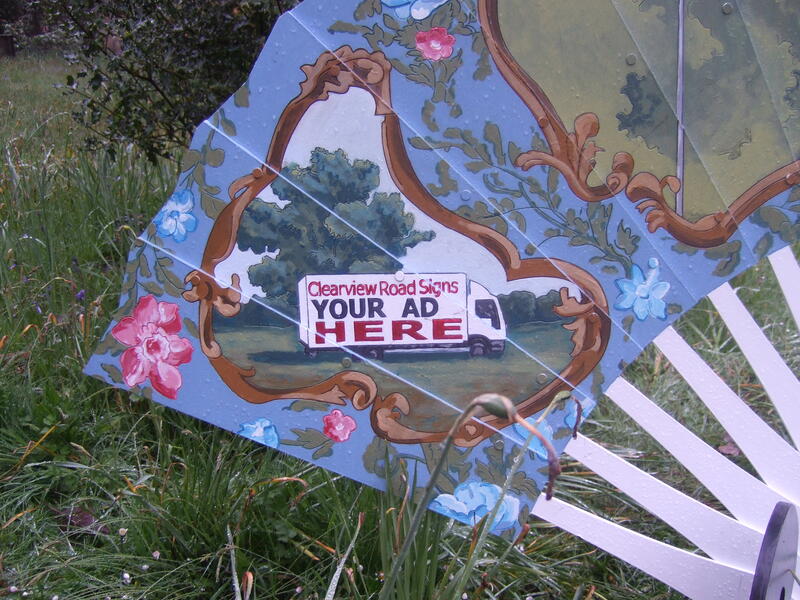 Road to Nymans FanSecond fan on display in the Nymans House and Gardens. Road to Nymans pictures the M23 roadway, the main thoroughfare between London and Nymans, which elevates with absurd revisions of the ornamental fan scenes, challenging site-specific concepts of fantasy and utopia.
Road to Nymans FanSecond fan on display in the Nymans House and Gardens. Road to Nymans pictures the M23 roadway, the main thoroughfare between London and Nymans, which elevates with absurd revisions of the ornamental fan scenes, challenging site-specific concepts of fantasy and utopia. -
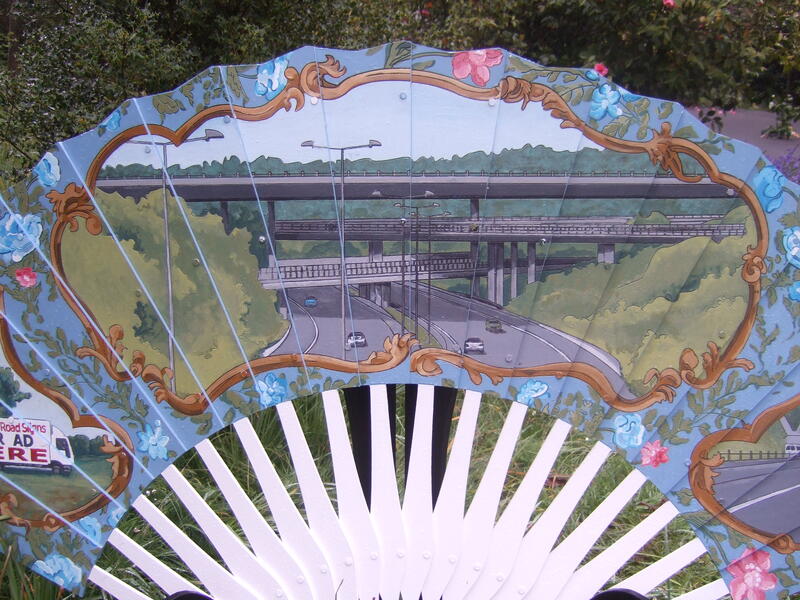 Road to NymansSecond fan on display in the Nymans House and Gardens. Road to Nymans pictures the M23 roadway, the main thoroughfare between London and Nymans, which elevates with absurd revisions of the ornamental fan scenes, challenging site-specific concepts of fantasy and utopia.
Road to NymansSecond fan on display in the Nymans House and Gardens. Road to Nymans pictures the M23 roadway, the main thoroughfare between London and Nymans, which elevates with absurd revisions of the ornamental fan scenes, challenging site-specific concepts of fantasy and utopia. -
 dscf0236a.jpg
dscf0236a.jpg -
 New Town Mock Tudor Fan
New Town Mock Tudor Fan -
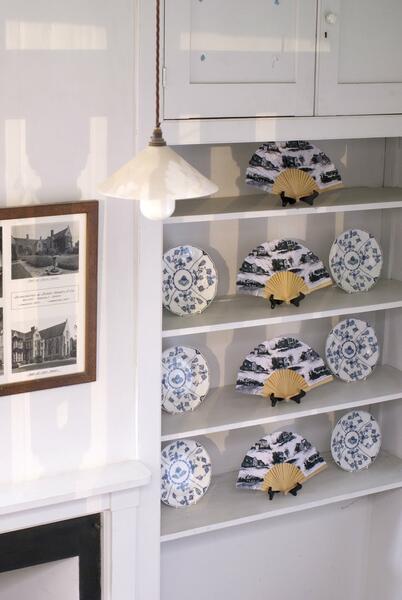 New Town Mock Tudor Fans
New Town Mock Tudor Fans

